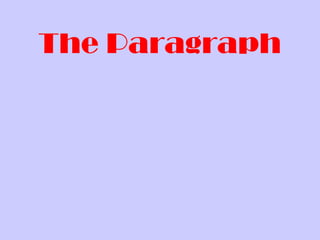
The paragraph notes
- 2. Title necessary relevant Introduction Body Conclusion Topic Sentence (1-2 sent.) Detail Sentences (3-8) Lead Off Follow Up Clincher Sentence (1 sent.)
- 3. Practice Retrieve the paragraph you have due today. Reread it slowly. When you finish, complete the following: * label your topic sentence * label your paragraph’s body * label your clincher sentence Make sure your name is at the top of your paper, and prepare to turn it in.
- 4. Topic Sentence • Is usually the first sentence • Introduces the main idea • Sometimes hints at or introduces details
- 5. General Topic Sentence • Simply names the main idea of the paragraph • The hot trend in advertising these days is to hire real Hollywood stars. • Kevin James would have been 20 years old this September. • Not much is left of a town known as Nora, Nebraska • Democracy is thriving at Hillsboro High School.
- 7. Clueing Topic Sentence • Names the main idea, and • gives a clue about the details. • The four seasons spice up our lives. • Tents come in a variety of shapes and sizes. • The citizens of Lawrence have several reasons for building a new high school. • Jesse Flynn is my best friend because of his many fine characteristics.
- 8. FOUR FABULOUS FLAVORS! CANDY JELLY BEANS
- 9. Specific Topic Sentence • Names the main idea, and • names the specific details to be covered in order. • Air pollution is caused by both vehicles and industries. • Charles Darwin lived an interesting life as an explorer, writer, and scientist. • Diseases caused by vitamin deficiencies are beri beri, pellagra, scurvy, and rickets.
- 11. Detail Sentence • Discusses one of the details in the paragraph. • Sometimes shows the relationship between a detail and the rest of the paragraph.
- 12. Requirements for detail sentences Each detail sentence must: • Contain related information • Be in logical sequence with other sentences. • Include a transition if it introduces a new detail. • Be written from the same point of view as other sentences. • Be written in the same tense as the other sentences. 1st , 2nd , or 3rd ! past, present, or future!
- 13. Lead-off Sentence • Introduces a new detail, and • contains a transition.
- 14. Transition • Signals the introduction of a new detail. • Shows the relationship between the detail and the rest of the paragraph.
- 15. Follow-up Sentence • Provides more information about the detail. • May be more than one for each detail.
- 16. Example Detail Sentences Topic sentence: Turtles could not survive without their shells. Detail sentences: Most importantly, turtles’ shells serve as the base of their skeletons. Their backbones and ribs are attached to the flat bony plates of their shells. This skeleton provides shape for their bodies.
- 17. Detail sentences (continued) Also important, turtles’ shells serve as their portable homes. Turtles can live anywhere because they carry their homes with them. This is crucial since they move so slowly.
- 18. Finally, turtles’ shells are important because the shells protect turtles from their enemies. Turtles who are in danger can pull their heads and legs into their hard shells to protect themselves from animals who might try to eat them. Detail sentences (continued)
- 19. Detail Sentence Sequences • Size Sequence – when details are larger/smaller than each other. • Time Sequence – when some details occur before others in time. • Space Sequence – when details are arranged in space in relation to each other.
- 20. • Importance Sequence – When some details are more important than others • Chain-link Sequence – When details are related in pairs or related but not in any of the above sequences. Detail Sentence Sequences (continued)
- 21. Clincher Sentence • Is the last sentence in the paragraph. • Closes the paragraph. • Names the main idea of the paragraph. • Sometimes summarizes or names the details of the paragraph. • Is different from the Topic Sentence. • Contains a concluding transition.
- 22. Concluding Transitions • Words that tell the reader that the paragraph is finished. • See transitions page.
- 23. General Clincher Sentence • Summarizes the main idea of the paragraph. • Makes the reader think more about the topic. • Shouldn’t be a question.
- 24. Examples of General Clinchers In summary, these car models are my favorites. In conclusion, when life gives you lemons, make lemonade. Thus, if a person has approval from others, he may be less happy than if he has his own approval.
- 25. Clueing Clincher Sentence • Also names the main idea, and • ties the details together with a clue word • See your list of clue words.
- 26. Examples of Clueing Clinchers In sum, these four events served as the spark that ignited the war. In other words, several issues need to be considered before a person accepts a job offer. In conclusion, plenty of serious reasons exist for staying away from drugs.
- 27. Specific Clincher Sentence • Names the main idea, and • names the specific details that were covered in the paragraph in the order they were covered.
- 28. Examples of Specific Clinchers To conclude, making a snowman involves rolling the parts of his body, stacking the parts, and creating his face and clothes. In effect, the people followed a clear course: they wrote a petition, held rallies, demanded a vote, and caused the law to be changed.